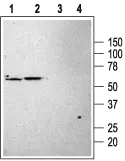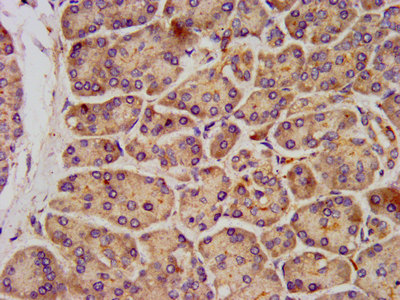
WB analysis of rat brain (1, 3) and pancreas (2, 4) membrane lysates using GTX54778 KCNK3 antibody preincubated with or without immunogen peptide. Dilution : 1:200
KCNK3 antibody
GTX54778
ApplicationsImmunoFluorescence, ImmunoPrecipitation, Western Blot, ImmunoCytoChemistry, ImmunoHistoChemistry
Product group Antibodies
TargetKCNK3
Overview
- SupplierGeneTex
- Product NameKCNK3 antibody
- Delivery Days Customer7
- ApplicationsImmunoFluorescence, ImmunoPrecipitation, Western Blot, ImmunoCytoChemistry, ImmunoHistoChemistry
- CertificationResearch Use Only
- ClonalityPolyclonal
- Concentration0.8 mg/ml
- ConjugateUnconjugated
- Gene ID3777
- Target nameKCNK3
- Target descriptionpotassium two pore domain channel subfamily K member 3
- Target synonymsK2p3.1, OAT1, PPH4, TASK, TASK-1, TASK1, TBAK1, potassium channel subfamily K member 3, TWIK-related acid-sensitive K(+) channel 1, TWIK-related acid-sensitive K+ 1, TWIK-related acid-sensitive K+ channel, acid-sensitive potassium channel protein TASK, acid-sensitive potassium channel protein TASK-1, cardiac potassium channel, potassium channel, two pore domain subfamily K, member 3, potassium inwardly-rectifying channel, subfamily K, member 3, two P domain potassium channel, two pore K(+) channel KT3.1, two pore potassium channel KT3.1
- HostRabbit
- IsotypeIgG
- Protein IDO14649
- Protein NamePotassium channel subfamily K member 3
- Scientific DescriptionThis gene encodes a member of the superfamily of potassium channel proteins that contain two pore-forming P domains. The encoded protein is an outwardly rectifying channel that is sensitive to changes in extracellular pH and is inhibited by extracellular acidification. Also referred to as an acid-sensitive potassium channel, it is activated by the anesthetics halothane and isoflurane. Although three transcripts are detected in northern blots, there is currently no sequence available to confirm transcript variants for this gene. [provided by RefSeq, Aug 2008]
- Storage Instruction-20°C or -80°C,2°C to 8°C
- UNSPSC12352203






